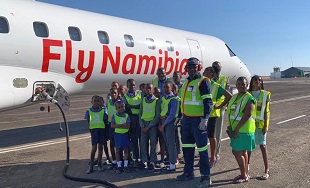
Learners from Otala Combined School learn more about aviation fuel

A group of 15 learners from Otala Combined School in Ondangwa, last week, learned that modern jet aircraft need specialised aviation fuel to keep these highly technical planes flying. As guests of Puma Energy, the learners became aware of this at the Ondangwa Airport.
Puma Energy said as future passengers travelling on commercial jet aircraft, the learners now know that these planes use Jet A or Jet A-1 fuel and that aviation fuel needs to be stored, handled, and refuelled with strict adherence to the highest safety standards at airports.
General Manager at Puma Energy, Addel Samuelson said this is the first time that learners from Ondangwa have been exposed to the aviation industry and specifically to the significance of aviation fuel and expressed the hope that similar learning experiences for more learners can be arranged in the future.
Puma Energy further said although the learners were exposed to a small but very important part of the aviation industry, they are in awe of the industry, and that it offers multiple career opportunities. “Pilots, cabin crew, engineers, technical crew, and logistics personnel all have a role to play, or some might even become very valuable Puma Energy team members who manage, store, handle or pump according to the strictest safety measures at airports,” they said.
They further explained that Puma Energy contributes to Namibia’s energy security by supplying aviation fuel 24/7 to airlines flying in to and out of Hosea Kutako International, Ondangwa, and Eros airports. “It is one of the top role players in this sector, with 61 retail fuel stations across the country. Fuel is also stored at two terminals in Walvis Bay with a storage capacity of 116 375 m3, dedicated to supplying Puma downstream operations,” they emphasised.
They highlighted that the learners came to know about the sources of oil, how oil is refined, and finally how it ends up at Puma Energy’s depots, and they were told about Puma Energy’s strict quality control measures at their aviation fuel depots including maintenance programmes, which are critical to ensure smooth operations at all times.
“The learners witnessed how a Fly Namibia passenger jet plane was refuelled and learned that most used fuels for commercial aviation are Jet A and Jet A-1, which are produced to a standardize international specification,” they said.
They said sustainable aviation fuel development has been making strides in an industry-wide effort to achieve carbon neutrality by 2050 and bio-fuels, also referred to as sustainable aviation fuel, are ecologically friendly alternatives to the conventional fossil-based fuels used in aviation.
The visit was made possible through collaboration with the Namibia Airports Company and Fly Namibia.
 Learners from Otala Combined School watched a jetliner of Fly Namibia being refuelled at the Ondangwa airport.
Learners from Otala Combined School watched a jetliner of Fly Namibia being refuelled at the Ondangwa airport.












































